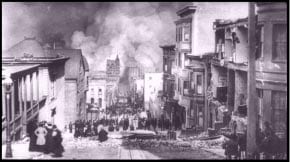
The Mechanical Game of Chance:
Invention 80 Years before Silicon Valley
By Rick Crandall
Mechanical coin-operated gambling machines, usually called “slots,” have been popular for well over 100 years. The locus of manufacturing of the most popular of these machines in their heyday was Chicago, but the early creations that proved to ignite the category were created in San Francisco by an immigrant from Germany who sought the freedom and opportunity that was uniquely American.
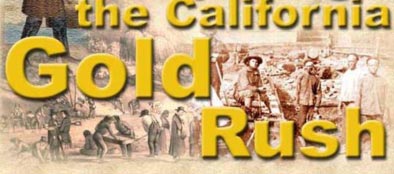
Many kinds of game machines and “trade stimulators” exploded onto the scene in the 1890’s – poker machines, penny-drop machines and by the latter part of that decade, the three-reeler came on the scene.
It was Charles Fey, a 29 year old mechanic, who cobbled together the first coin-payout, three-reel slot machine that rang a bell upon payout. That was in 1889, in San Francisco. Fey called his invention the Liberty Bell.
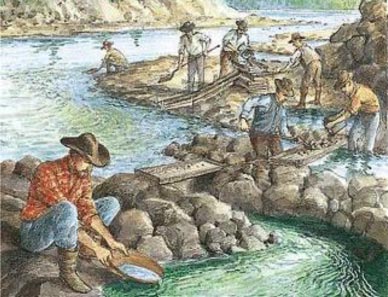
It may seem too much glorification to ascribe to the category of slot machines, the invention, creativity and the spirit of “can do anything” that is so American and so typifies the technology industry that was to form 80 years later, also in the San Francisco area.
The men that “went west” were risk takers to be sure. The West coast was a ready market for gambling machines and was also host to the entrepreneurial spirit that embodied another form of risk-taking, namely the California Gold Rush. It all came from the same spirit and it defined the early Americans. It is a spirit that transitioned into the innovation and grit that turns dreams into reality so typified by Silicon Valley’s techies and venture capitalists. We can only hope we don’t lose that spirit and freedom in an age of regulation and entitlement today.

from the San Francisco “The Call”
“Slot Machines”
“The desire of everybody to take chances is that which leads to enterprise and lends variety to life. No man, woman or child is there that does not desire to try his or her luck. This opportunity is afforded by many devices which collectively carry the name of slot machines.
“There are few men in the land who have not played the slot machine and there are few who do not find the charm of this practice sufficient to lure them to practice it with great regularity.”
Innovation and entrepreneurialism was certainly alive in San Francisco back in 1900. Betting on new frontiers, a rapidly growing America provided an ideal place for the development of coin-activated gambling. While the earliest devices were conceived on the east coast, the device that gave birth to the machine that lit up the market place, was the Liberty Bell which was tinkered together by Charles Fey in 1898-9.
Why San Francisco? Start with the discovery of gold in the California Sierra that attracted every kind of adventurer, risk taker and dreamer – just the personality types who would take to mechanized gambling. Far from the restraint of Eastern influences of government and church, the California pioneers were in a wide open space with bets placed on just about anything that had a variable outcome.
Charles Fey 1862-1944: A Brief Biography
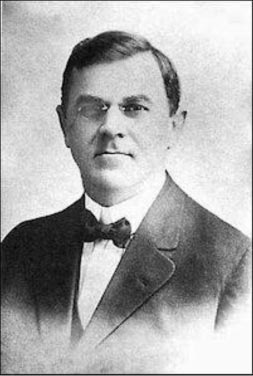
Born: Bavaria, Germany Feb 2, 1862
Died: San Francisco, USA Nov 4, 1944
Charles Fey was born as August Fey on February 2, 1862, in a small village called Vohringen, in Bavaria. He was the youngest child of 16.
During a school vacation, at the age of 14, he joined his older brother, Edmund, to work in a farm tool factory in Munich. There, he first discovered his passion for mechanical devices.
After returning home, the difficulties of living in his father’s strict household, and the risk of being drafted into the German army, made the opportunities found in America very appealing. His uncle, Martin Vollman, had successfully immigrated to New Jersey in the 1850’s, and therefore August decided to follow.
He left home at the age of 15, and headed for France where he took a job with an intercom equipment manufacturer. He saved just enough money to cross the English Channel, and lived in London for the next five years. There he worked as a nautical instrument maker while he saved for passage to America, arriving in New York.
At first, he lived with his uncle’s family, but when they returned to Germany he decided to leave the harsh winters of the Northeast and journeyed to California.
He arrived in San Francisco during the spring of 1885 and took various jobs as a machinist, finding employment at the California Electric Works company (the predecessor to Western Electric), at the age of 25.
Fey married Marie Volkmar, a native Californian, with whom he had three daughters and a son. In 1889 Fey Americanized his name, and became Charles August Fey.
Influenced by the abundance of nickel-in-the-slot machines in San Francisco, Fey scrabbled together his first machine in 1894. It was a three-wheel machine, and was similar to one first made the previous year by Gustav Shultze, a known manufacturer and operator of slots.
Later in that year, Charles Fey and Theodore Holtz, a co-worker, quit their jobs at California Electric Works, and formed a new company to compete with their former employer, manufacturing telephone, telegraph, and electrical equipment. The new business was coincidentally located on the same block as Shultze’s slot manufacturing company, and they may have even manufactured parts for Shultze’s machines.
The Fey Liberty Bell
In 1895, Fey moved to Berkeley, where he built his second slot machine in his basement. This machine was called the 4-11-44, a name that was based on Policy, a popular but illegal lottery game at the time. Policy had three concentric numbered dials, with a three-digit combination being called a “gig.”
4-11-44 was a popular sequence in Policy because while it almost never occurred, it was the top-paying combination with a $5.00 payout that was especially alluring to the poor and the Negro populations.
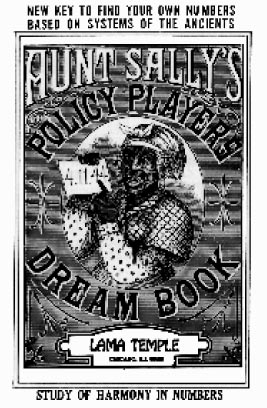
A book called “Aunt Sally’s Policy Players Dream Book” was popular, describing dreams with interpretations and lucky numbers for playing Policy. It was one of the few books many Policy players had ever read.
The first Fey 4-11-44 was placed in a salon, and became so popular that Fey promptly created a few more, and decided to devote his full time to designing and manufacturing slot machines.
In 1896 Fey formed a factory on Market Street in San Francisco and left his share of the electrical equipment business to his partner, Holtz.
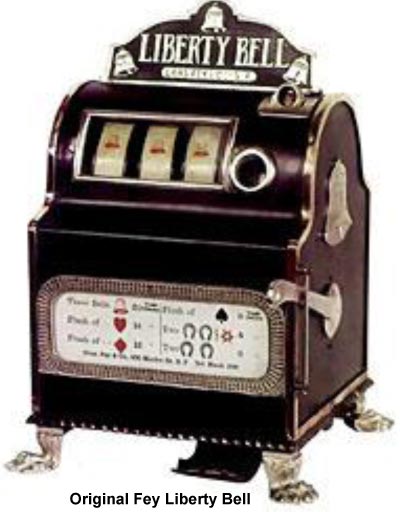
Original Fey Liberty Bell
Do you know where one is?
There were a number of reasons for the popularity of the three-reel bell slot. It had a suspense factor with the first, then second and then third reel stopping in succession. With ten symbols per reel, the possible combinations were large and foiled the player from mentally calculating how far the odds were against him. By 1899 Fey was making machines branded as the “Liberty Bell” named after an obvious patriotic symbol and playing off the bell ringer.
Fey adopted a business model of only operating his machines on location rather than selling them. The best way a competitor could copy it (there was no patent protection for these machines) was to steal one.
The Mills, Caille … Copy-Bells
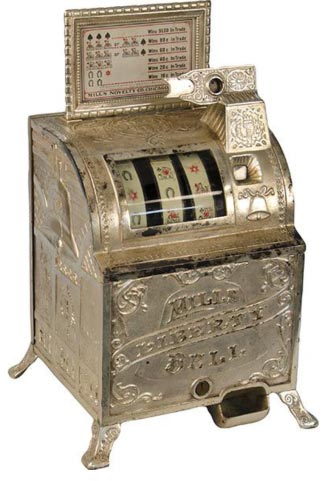
In 1905 a Fey Liberty Bell mysteriously appeared in the Mills Novelty Company plant in Chicago. Soon after, Mills had a Liberty Bell on the market with attractive cosmetics – an all-cast iron case with fancy patterns in the castings and nickel plated.
Mills was already an entertainment machine powerhouse and they were quickly followed by Caille Brothers of Detroit. Caille was the “Cadillac” of gambling machines which showed in the attractiveness of its case designs. Caille had a Liberty Bell on the market shortly after Mills, all around 1910.
One might guess that Fey was none too pleased with Mills, although their adoption of the 3-reeler surely helped establish a national market opportunity for everyone, Fey never could patent his machine, because there was too much prior art in its components.
April, 1906: The San Francisco Earthquake
One year after Fey saw his Liberty Bell being copied, he had another major challenge to face. The 1906 San Francisco earthquake dealt the greatest destruction of wealth created by human hands in recorded history. Over 225,000 of the City’s 400,000 residents were rendered homeless.
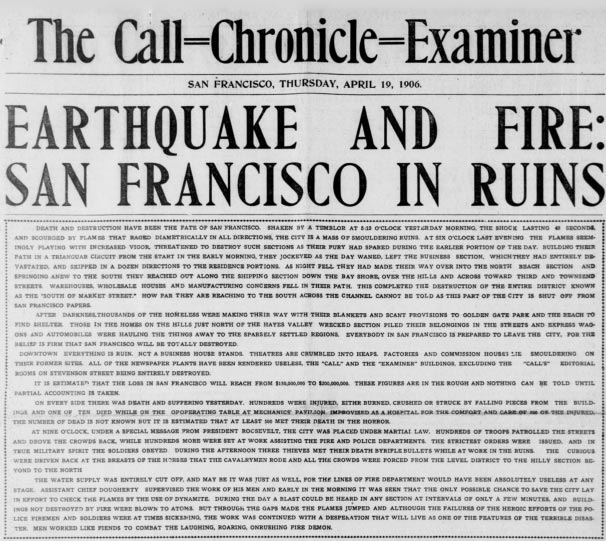
When Charlie Fey returned to his burned-out factory, he searched the ruins and found all that remained was the façade and a pile of charred bricks. The earthquake was a boon to the Midwest manufacturers of gaming equipment in that many machines destroyed by the earthquake would be replaced with new orders, and the manufacturing plants of Chicago and Detroit were far from the earthquake damage.
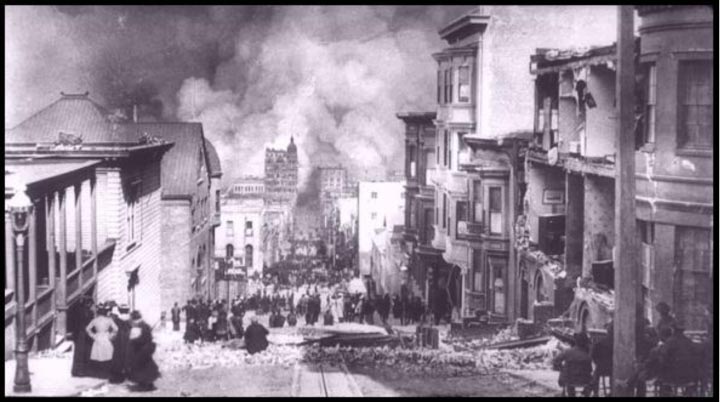
Devastating as the earthquake was, Fey rebuilt in a new facility – and the market was strong enough that he had plenty of opportunity to sell machines as he got back up off his knees.
California Law Catches Up
What really caused Fey a problem was the tide of California state regulations culminating in a State law banning slot machines after June 22, 1909. As stated in the San Francisco Call:
“By signing assembly bill 870, Governor Johnson today consigned to the junk pile all slot machines … and when the hungry nickel-eaters are down and out the law provides that there shall be no substitute for them …”
The Operator Bell
At about that same year, 1909-10, the Chicago and Detroit slot manufacturers (Mills, Caille, Watling) improved the Liberty Bell and created the Operator Bell. The first version of the Operator Bell still sported a fancy cast iron case, but was designed for heavier use.
From: Dick Bueschel’s Illustrated Price Guide to the 100 Most Collectible Slot Machines
“If any single machine created the slot machine boom of the teens, twenties and thirties, it was the early “Iron Case.” Called the Operator Bell, it was the first in a long line of Bell machines with fruit symbols that are most sought after by collectors.”
“The Operator Bell was a re-engineered Liberty Bell, created for the heavy play that the earlier model had initiated. Its name was its own advertising. It was a Bell machine made for operators, a new form of independent business man that owned machines, placed them on locations on routes, and split the take – historically 50/50 with the location. The operators called the machine the “Iron Case.”
“The idea of fruit symbols on the reels was created to beat the laws. Caille started it with its “G-U-M” reel. A gum vending attachment was initially made part of the machine so that a nickel played was a stick of gum paid, plus any lucky winnings. “
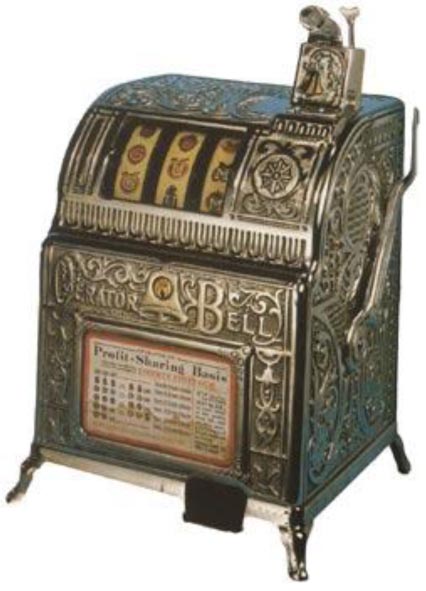
Caille Operator Bell. Note the G-U-M reel strips and the coin plunger on top. See Fey’s changes later in this article.
Mills actually succeeded in patenting the gum vendor in 1911 and had previously copyrighted the fruit symbols in 1910, but soon everyone was copying them. The gum idea worked initially, implemented with gum vender side attachments, but soon laws caught up, and the feature was dropped from the gambling machines and their sales were focused on markets that still allowed them.
There are quite a number of variations of cast-iron cabinet variations of the Iron Case with Liberty Bell and Operator Bell graphics applied in a number of ways. The Operator Bell that was the launch machine for the nascent industry.
Fey Moves to the Midwest
With the California slot ban ending the “good old days of Frisco,” Fey left town and headed for Chicago in 1911. There, according to the book “Slot Machines” by grandson Marshall Fey, he worked in John Watling’s Scale Company. While there he invented a coin-op beam scale. In 1912 he moved from Watling’s factory to Fond du Lac, Wisconsin to open the Pacific Scale Works with a partner. Less than two years later, Charlie Fey left and returned to San Francisco to open the Charles Fey & Co. Weighing Scales on Mission St. where he remained for the next 19 years.
Fey Gets Back into Slots by “Improving” Others’ Machines
Charlie couldn’t keep his hands out of the slot business, so in addition to building weighing machines, he also engaged in repair and revamping slot machines made by others. That became a viable business especially when Nevada, in 1912 legalized slot machines with certain restrictions.
He continued to innovate with his revamps, some of which were copied by the trade. For some markets he’d add a gum vendor to circumvent laws that were late in catching up. He also added a viewing window under the coin entry so slugs could be spotted visually. Fey reel strips with standard fruit symbols replaced the obsolete symbols that spelled G-U-M.
An early example of a Fey-revamped Caille cast-iron Operator Bell is shown here. He replaced the Caille coin entry that had the plunger, which confused players, with a simpler “gooseneck” design. He cut a circular hole under the chute for visual slug detection, a feature that soon became designed into cases as a standard around the trade. He changed the strips to his standard 20 symbol reel strips, (although the mech is still a 10 stop mechanism, probably indicating a Liberty Bell mech in an Operator Bell case, see catalog description below). Little did the gamblers know that the machine would never stop on half of the symbols. Finally, he inserted his own award card with his identification.
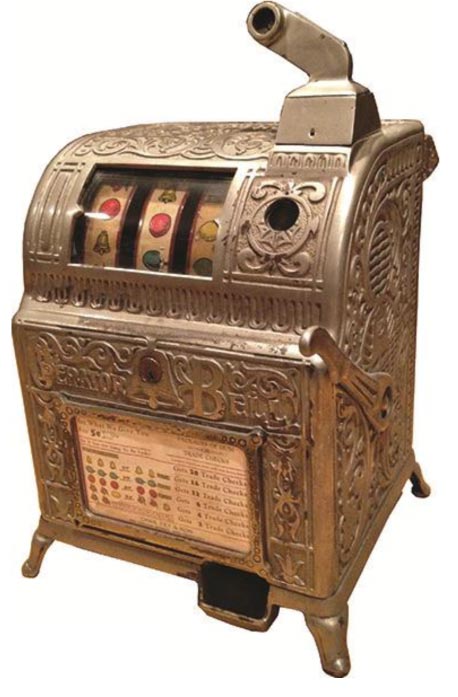
Above: Fey-revamped Caille Operator Bell
Below: Fey award card
Rick Crandall Collection
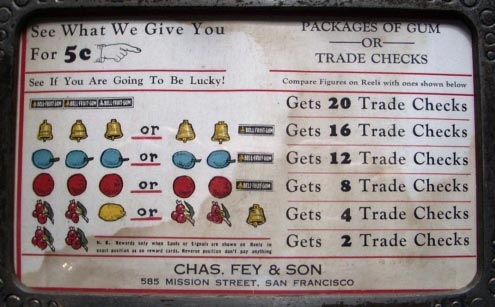
This from a Caille catalog page, circa 1911. This must have been a transition year from Liberty Bell to Operator Bell since both are offered interchangeably.
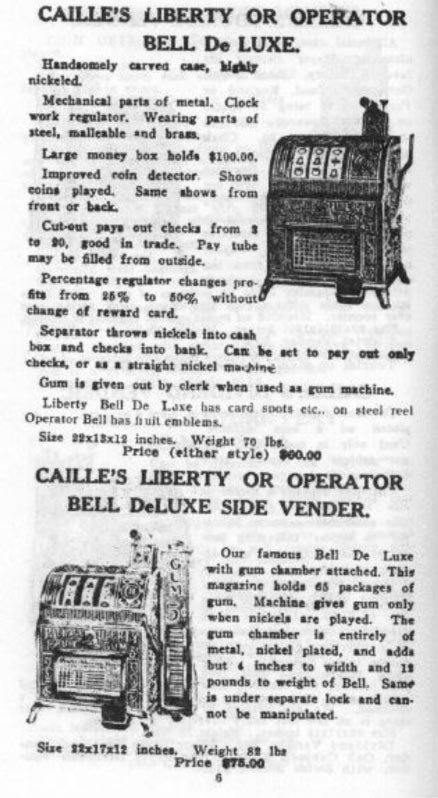
Note a few things:
- Liberty Bell comes with card spots as reel symbols whereas the Operator Bell has the enduring fruit symbols.
- A separator keeps the real nickels in the coin box whereas the trade checks (detected by a hole in the middle) is directed to the payout tube so the machine will only payout trade checks to maintain legality of the machine.
- The “percentage regulator” is essentially a cheater that can be set to give the house as high as 50% of the money played!
- The Side Gum Vendor model only has to deliver a pack of gum when a real nickel is played, so when a trade check is played – no gum is dispensed.
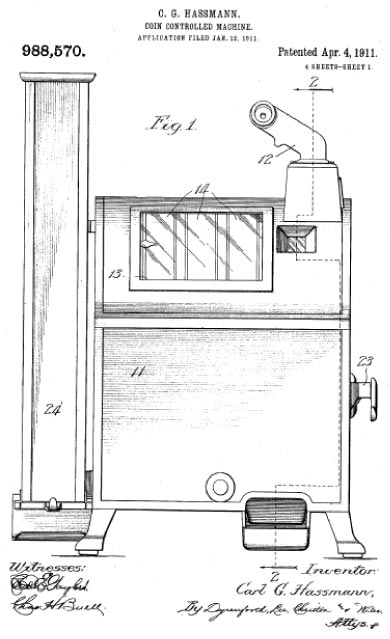
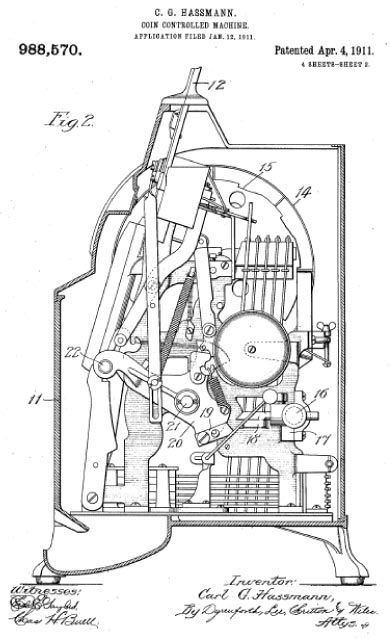
Mills patent for side gum vendor – the only early patent anyone was able to get issued, although it was never used as a defense against copy-cats.
Innovation vs. Regulation
The ready reception of slots by the market was challenged by strong resistance from crusading reformers who sought to stamp out the devices. As fast as laws were passed outlawing a given definition of gambling, the clever inventors would design a machine that worked in a way to foil the definition. For example, Gustav Schultz patented a chance feature on a “money-back” weighing scale, the defense being that the patron spent the coin for his weight and whatever else he got back in addition was just gravy.
Adolf Caille produced a machine that dispensed a stick of stale gum (if you wanted it) for each play of a nickel (i.e. a “gum vendor”) but in addition you might win back some coin.
When laws caught up with the gum vendors, the entrepreneurs came up with the very clever “future pay” machines such as the one pictured by Caille.
- You drop a nickel, pull the handle and you always get a pack of gum The word “GUM” appears in the little circular window (if you don’t remove the gum is stays there for the next play – very efficient) and nothing else for that nickel – no gambling there, right?
- However in addition to the gum, if you had a winning combination on the reels, a number would appear on a rotating dial through the little window. This number was the number of nickels you get for sure if you played another nickel. No element of chance there either, the payout was guaranteed for that next nickel!
This machine went further in that it was played with “trade checks” or nickels. The trade checks were used in locations where real cash payout was illegal. Instead the machines would pay out in trade checks, or essentially coins minted allegedly good only in trade for cigarettes, mints, gum or additional gambling. Of course the house would cash your trade checks into cash just as casinos will with chips today.
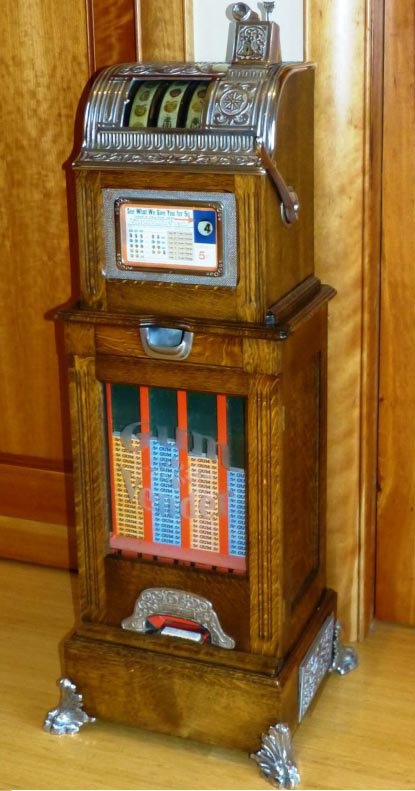
Caille “DeLuxe Cabinet gum vendor, future-pay
Rick Crandall Collection
This cat and mouse game extended for years until it became quite clear that gambling was legal in Nevada and nowhere else – all the way until Atlantic City came on the scene many years later.
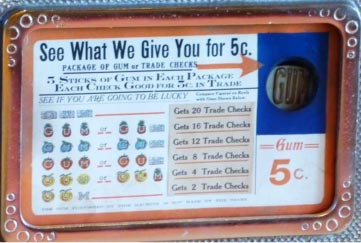
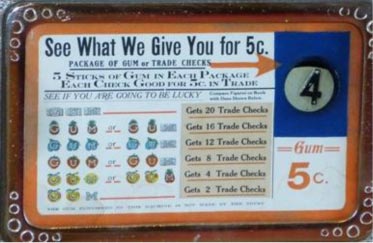
Award card on Caille Future-Pay Gum Vendor. To the left see “GUM” in window meaning no winnings on this play; to the right player got a winning combination, and by playing one more nickel, he’ll get that nickel back plus 4 more for sure.
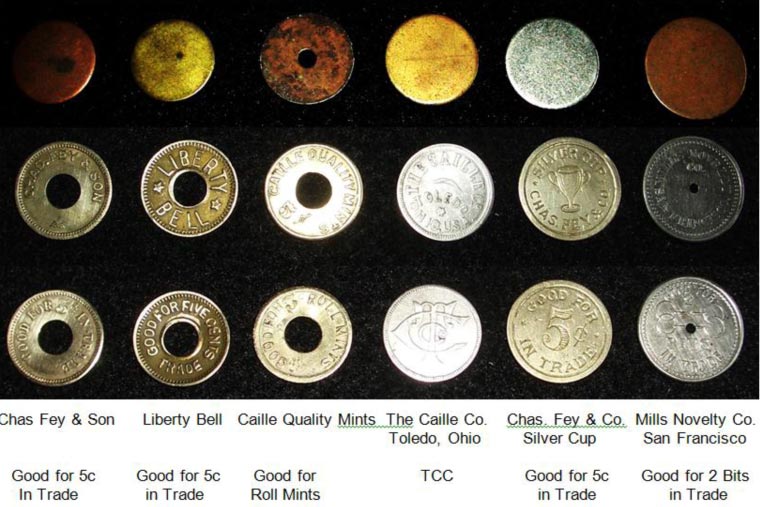
Upper row: various brass, copper and steel slugs that were in actual use, and well worn; Middle row are several trade checks (third row is flip side) that were made for various manufacturers and even for specific machines. Note the claim that they were only good in trade, although the right-most token makes a mockery of that offering 2 Bits in “trade.”
From a Caille catalog page circa 1911 promoting the floor model gum vendor.
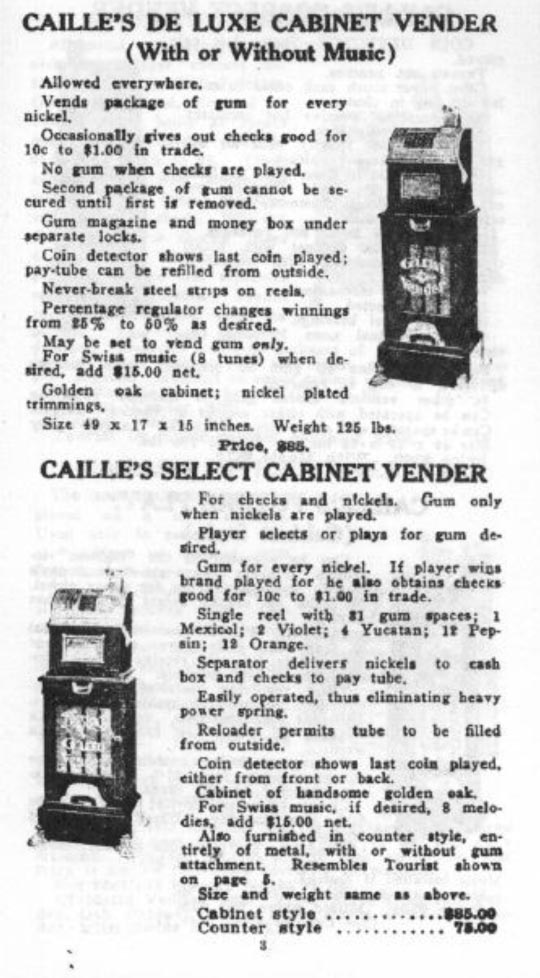
Note a few things:
- Can be set to vend gum only – presumably for times when a bust was expected?
- Cute how they say “occasionally gives out checks good for 10c to $1.00 in trade.” Yeah right.
- The future-pay feature is not yet offered, since the gum-vending and trade-check strategies were working at that time. When the laws caught up with that, then the future pay feature was added – cat and mouse!
All through the decades to follow, slot machine designs changed, features were upgraded but the basic principles popularized by Charlie Fey from his “garage shop” tinkering in San Francisco, have endured.
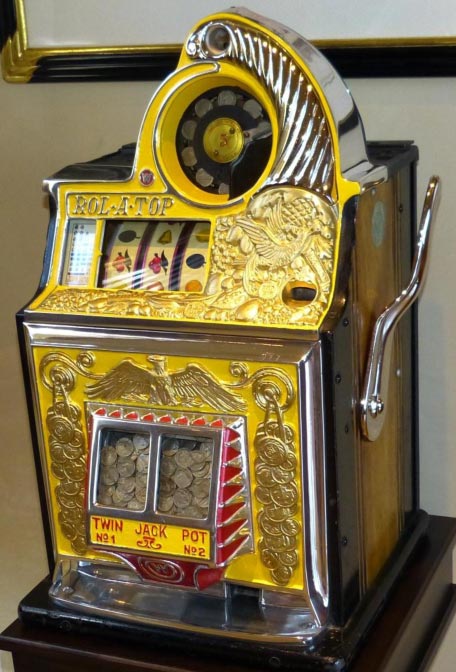
1930’s Watling Rol-a-top Bird of Paradise slot machine with double jackpot, rotating coin display (fancy way of spotting slugs), but still using the iconic cherries on reel strips that go back to the original 1910 Operator Bell.
Rick Crandall Collection


